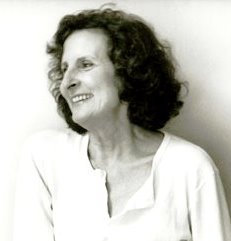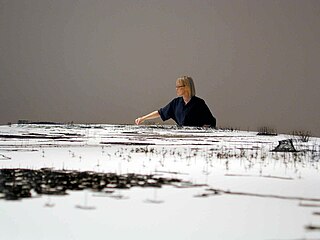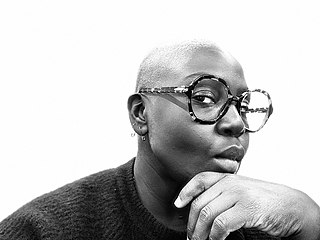Related Research Articles

Trisha Brown was an American choreographer and dancer, and one of the founders of the Judson Dance Theater and the postmodern dance movement. Brown’s dance/movement method, with which she and her dancers train their bodies, remains pervasively impactful within international postmodern dance.

Mary Lucier is an American visual artist and pioneer in video art. Concentrating primarily on video and installation since 1973, she has produced numerous multiple- and single-channel pieces that have had a significant impact on the medium.
Carrie Mae Weems is an American artist working in text, fabric, audio, digital images and installation video, and is best known for her photography. She achieved prominence through her early 1990s photographic project The Kitchen Table Series. Her photographs, films and videos focus on serious issues facing African Americans today, including racism, sexism, politics and personal identity.

Anne Wilson is a Chicago-based visual artist. Wilson creates sculpture, drawings, Internet projects, photography, performance, and DVD stop motion animations employing table linens, bed sheets, human hair, lace, thread and wire. Her work extends the traditional processes of fiber art to other media. Wilson is a professor in the Department of Fiber and Material Studies at The School of the Art Institute of Chicago.

Jonah Bokaer is an American choreographer and media artist. He works on live performances in the United States and elsewhere, including choreography, digital media, cross-disciplinary collaborations, and social enterprise.
Sanford Biggers is an American interdisciplinary artist who works in film and video, installation, sculpture, music, and performance. A Los Angeles native, he has lived and worked in New York City since 1999.

Elad Lassry is an American artist who lives and works in Los Angeles.
Lari George Pittman is a Colombian-American contemporary artist and painter. Pittman is an Emeritus Distinguished Professor of Painting and Drawing at the UCLA School of the Arts and Architecture.

Simone Leigh is an American artist from Chicago who works in New York City in the United States. She works in various media including sculpture, installations, video, performance, and social practice. Leigh has described her work as auto-ethnographic, and her interests include African art and vernacular objects, performance, and feminism. Her work is concerned with the marginalization of women of color and reframes their experience as central to society. Leigh has often said that her work is focused on “Black female subjectivity,” with an interest in complex interplays between various strands of history. She was named one of the 100 most influential people in the world by Time magazine in 2023.
Anicka Yi is a conceptual artist whose work lies at the intersection of fragrance, cuisine, and science. She is known for installations that engage the senses, especially the sense of smell; and, for her collaborations with biologists and chemists. Yi lives and works in New York City.
Brendan Fernandes is a Canadian contemporary artist who examines issues of cultural displacement, migration, labor, queer subjectivity, and collective agency through interdisciplinary performance that uses installation, video, sculpture, and dance. He currently serves as a faculty member at Northwestern University teaching art theory and practice.
Sarah Michelson is a British choreographer and dancer who lives and works in New York City, New York. Her work is characterized by demanding physicality and repetition, rigorous formal structures, and inventive lighting and sound design. She was one of two choreographers whose work was included in the 2012 Whitney Biennial, the first time dance was presented as part of the bi-annual exhibition. Her work has also been staged at The Walker Art Center, Jacob’s Pillow Dance Festival, The Kitchen, and the White Oak Dance Project. She received New York Dance and Performance awards for Group Experience (2002), Shadowmann Parts One and Two (2003), and Dogs (2008). She has served as associate director of The Center for Movement Research and associate curator of dance at The Kitchen. Currently choreographer in residence at Bard's Fisher Center, she is the recipient of their four-year fellowship to develop a commissioned work with Bard students and professional dancers.
Aki Sasamoto is a New York-based artist working in performance and installation. Sasamoto has collaborated with visual artists, musicians, choreographers, dancers, mathematicians and scholars, and is co-founder of the nonprofit interdisciplinary arts organization Culture Push. She was appointed as Assistant Professor in Sculpture at the Yale School of Art in July 2018.

Kambui Olujimi is a New York-based visual artist working across disciplines using installation, photography, performance, tapestry, works on paper, video, large sculptures and painting. His artwork reflects on public discourse, mythology, historical narrative, social practices, exchange, mediated cultures, resilience and autonomy.
A.K. Burns is a New York-based interdisciplinary visual artist, working with video, installation, sculpture, collage, poetry and collaboration whose works address trans-feminist issues. Burns is currently a fellow at Radcliffe Institute for Advanced Study at Harvard University. She graduated from Rhode Island School of Design and went on to receive an MFA in sculpture from Milton Avery Graduate School of the Arts at Bard College. Burns has been full-time faculty at Hunter College's Graduate Department of Art and Art History from 2015 to 2016 and a mentor at Columbia University. She has also taught at Parsons the New School for Design, Cooper Union and Virginia Commonwealth University. Burns was one of the first residents at the Fire Island Art Residency. Burns was a 2015 Creative Capital Awardee in the Visual Arts category and is represented by Calicoon Fine Arts, Galerie Michel Rein and Video Data Bank.

Arnaud Cohen is a French contemporary artist, sculptor, and visual artist.
Carolyn Lieba Francois Lazard is an American artist based in Philadelphia, Pennsylvania. Lazard uses the experience of chronic illness to examine concepts of intimacy and the labor of living involved with chronic illnesses. Lazard expresses their ideas through a variety of mediums including performance, filmmaking, sculpture, writing, photography, sound; as well as environments and installations. Lazard is a 2019 Pew Foundation Fellow and one of the first recipients of The Ford Foundation's 2020 Disability Futures Fellows Awards. In 2023, Lazard was selected as a recipient of the MacArthur Fellowship, colloquially known as the "genius grant."

Autumn Knight is an American interdisciplinary artist working with performance, installation, and text from Houston, Texas who lives and works in New York City.
Rashaad Newsome is an American artist working at the intersection of technology, collage, sculpture, video, music, and performance. Newsome's work celebrates and abstracts Black and Queer contributions to the art canon, resulting in innovative and inclusive forms of culture and media. He lives and works in Oakland, California, and Brooklyn, New York.
Shalom Gorewitz is an American visual artist. Gorewitz was among the first generation of artists who used early video technology as an expressive medium. Since the late 1960s, he has created videos that "transform recorded reality through an expressionistic manipulation of images and sound". His artworks often "confront the political conflicts, personal losses, and spiritual rituals of contemporary life". Gorewitz has also made documentary and narrative films.
References
- ↑ "Dance as Blood Sport: Performance Artist Yve Laris Cohen Tackles Ballet", David Everitt Howe, Modern Painters, March.]
- ↑ "Yve Laris Cohen :: Foundation for Contemporary Arts". www.foundationforcontemporaryarts.org. Retrieved 2018-04-19.
- ↑ “Yve Laris Cohen in conversation with R.E.H. Gordon on Coda” R.E.H. Gordon Critical Correspondence, March 8.
- ↑ Whitney Museum of American Art http://whitney.org/Exhibitions/2014Biennial
- ↑ Whitney.org Yve Laris Cohen.
- ↑ “Landing Field Vito Accounci and Yve Laris Cohen.” Bard CSS Program.
- ↑ Movement Research. Yve Laris Cohen.
- ↑ Art Forum. “You never look at me from the place from which I see you.”
- ↑ "Among Within and Elsewhere." Jenny Jaskey. Mousse Magazine. 2014
- ↑ “Passing the Bar.” Artforum